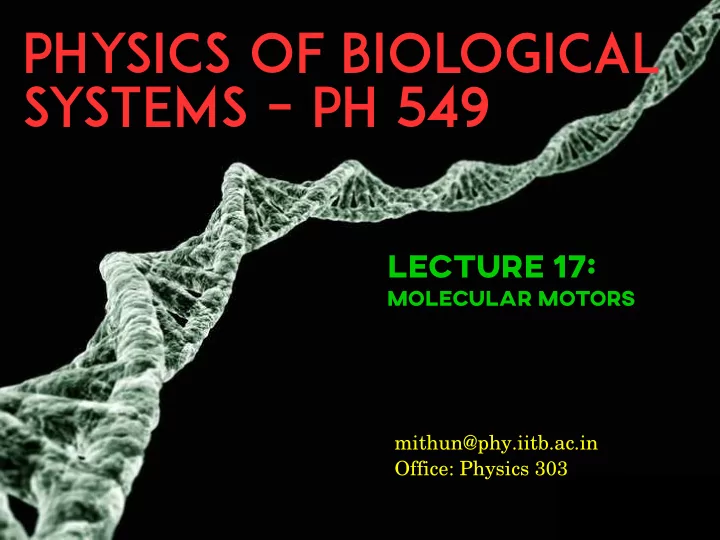

P h y s i c s o f b i o l o g i c a l s y s t e ms – P H 5 4 9 L E C T U R E 1 7 : Mo l e c u l a r mo t o r s mithun@phy.iitb.ac.in Office: Physics 303
T h e c h e mo me c h a n i c a l c y c l e C H E MI C A L E N E R G Y ME C H A N I C A L E N E R G Y Directed non-random motion ATP hydrolysis
R N A p o l y me r a s e mo t o r
T R A N S L A T I O N A L MO T O R S
T H E MY O S I N S U P E R F A MI L Y
F O R C E - V E L O C I T Y C U R V E S Different motors have different mechanisms
C h a r a c t e r i z a t i o n o f MO T O R S ➢ DIRECTION OF MOTION Kinesin – Plus-end-directed Dynein – Minus-end-directed ➢ SPEED OF THE MOTOR Kinesin step size – 8 nm Kinesin speed – 6 µ m/s ➢ FORCE EXERTED DURING A SINGLE STEP ( ) ~ F max Kinesin 10 pN ➢ PROCESSIVITY RNA polymerase – 1000s of bases Muscle myosin – 2-3 steps
B I D I R E C T I O N A L MO T I O N O F C A R G O Lu et. al. J. Vis. Exp. 81, 50838 (2013)
F O R C E G E N E R A T I O N
MU S C L E C O N T R A C T I O N
MU S C L E C O N T R A C T I O N
F O R C E S D U R I N G C E L L D I VI S I O N
F O R C E S D U R I N G C E L L D I VI S I O N
G L I D I N G A S S A Y S
G L I D I N G A S S A Y S
G L I D I N G A S S A Y S DeCamp et. al. Nature Materials 2015
B E A D - B A S E D S I N G L E MO T O R A S S A Y S
ME C H A N I S MS O F MO T O R MO T I O N
MO D E L S O F MO T O R MO T I O N
MO D E L S O F MO T O R MO T I O N ➢ What is the mean velocity of a motor ? ➢ How does the mean velocity depend on the applied force ? ➢ What is the stall force of the motor ? ➢ How does the velocity depend upon the concentration of ATP ? ➢ How stochastic are motor trajectories ? ➢ How do binding and unbind rates depend on applied force ?
B I D I R E C T I O N A L T U G o f WA R Soppina et. al. PNAS 2009 Rai et. al. Cell 2013
Martin et. al. Mol. Biol. Cell 1999 Ally et. al. J. Cell Biol. 2009
Leidel et. al. Biophys J. 2012 Rai et. al. Cell 2013
K i n e s i n D y n e i n Kunwar et. al. PNAS 2011
T h e d i s c r e t e P - s t a t e mo d e l p m ( n ,t ) = ?
T h e d i s c r e t e O n e - s t a t e mo d e l
T h e d i s c r e t e O n e - s t a t e mo d e l
T h e d i s c r e t e O n e - s t a t e mo d e l p ( n ,t +Δ t ) = k + Δ t p ( n − 1, t )+ k - Δ t p ( n + 1, t ) +( 1 − k + Δ t − k - Δ t ) p ( n ,t ) 2 p ∂ p = − V ∂ p ∂ x + D ∂ ∂ t 2 ∂ x V = a [ k + ( F )− k - ( F )] 2 D = a 2 [ k + ( F )+ k - ( F )]
T h e d i s c r e t e O n e - s t a t e mo d e l 1 −( x − Vt ) 2 / 4 Dt p ( x ,t ) = e √ 4 π Dt
Recommend
More recommend